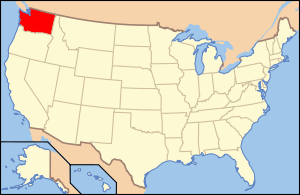Colonial Hotel (Seattle)
|
Colonial Hotel | |
|
The Colonial Hotel, September 2007 | |
| Location | 1119-1123 1st Ave., Seattle, Washington |
|---|---|
| Coordinates | 47°36′22″N 122°20′11″W / 47.60611°N 122.33639°WCoordinates: 47°36′22″N 122°20′11″W / 47.60611°N 122.33639°W |
| Built | 1892, 1901 |
| Architect | Max Umbrecht |
| Architectural style | Federal Style |
| NRHP Reference # | 82004232[1] |
| Added to NRHP | April 29, 1982 |
The Colonial Hotel is a historic building in Seattle located at 1119-1123 at the southwest corner of 1st Avenue and Seneca Streets in the city's central business district. The majority of the building recognizable today was constructed in 1901 over a previous building built in 1892-3 that was never completed to its full plans.
Built as a response to the boom created by the Yukon Gold Rush, the Colonial Hotel operated as a hotel into the 1970s and in the 1980s it was restored into apartments and connected to its southern neighbor, the Grand Pacific Hotel. Both were listed on the National Register of Historic Places in 1982. Today they are know collectively as the Colonial Grand Pacific.
History
Following the Great Seattle Fire of 1889, the northward expansion of Seattle's business district from Pioneer Square, already in the planning stages prior to the fire, took on a rapid pace. A quick glut of new office space created by the boom however left many buildings incomplete and many more lots undeveloped as the economy began to cool in 1891. The 4-story Starr Building, built in 1890 on the west side of 1st Avenue between Spring and Seneca Streets, stood alone on the block until a second wave of construction began in 1892.
The Kenyons
Jacob Gardner Kenyon, a traveling ventriloquist and magician, first passed through Seattle in the early 1880s and with the ticket sales from his first show at Yesler Hall, purchased several lots on 1st Avenue before leaving town, purchasing even more on his second tour. The value of his property skyrocketed following the great fire but he refused all offers to lease it.[2] In mid-1892, Kenyon commissioned prominent architect John Parkinson to design a six-story building of granite and white pressed brick to be built on his corner lot adjoining the Starr Building. Construction began in October 1892, and was only completed to the first floor on 1st Avenue, with the top 3 floors to be completed later.[3] Kenyon died on December 22, 1892 and the property, along with all of Kenyon's Seattle holdings was willed to his son, Benjamin Kenyon. Litigation involving unpaid loans and under-compensated heirs soon followed along with the Panic of 1893, preventing the completion of the building for the rest of the decade.
James Clise
In December 1900, Prominent Seattle businessman and investor James Clise purchased the incomplete Kenyon Building and one other nearby lot from the Kenyon Estate for $430,000 and immediately made plans to complete the building to house a hotel to meet the demands of a city once again booming as a result of the Yukon Gold Rush.[4] He commissioned architect Max Umbrecht, who had come to Seattle from Syracuse, New York earlier in the year under the employ of L.C. Smith. He designed several buildings for Smith's Pioneer Square properties and would go on to design several more for Clise and many more buildings in Seattle. Umbrecht chose an eclectic Federal motif for the top 3 floors of the building that would be built on top of the existing Kenyon building and likely inspire the hotel to be called the Colonial. In 1906 Clise sold the hotel to Sigmund Aronson and Harold Preston for $180,000.[5]
Weyerhaeuser
In the mid 1960's, while many small downtown hotels in Seattle were being closed by the city's Nuisance abatement board, The Colonial Hotel was deemed to still be in fine condition and was allowed to stay open.[6] Beginning in the late 70s, The Colonial and other historic buildings in the area were restored and redeveloped by Cornerstone Development Co, a subsidiary of Weyerhaeuser as part of the Waterfront Center project, which combined new construction with older buildings restored for housing.[7] During restoration, The Colonial Hotel was interconnected with the Grand Pacific Hotel to the south and the complex became known as the Colonial Grand Pacific Apartments. The Colonial Hotel was listed on the National Register of Historic Places on May 13, 1982.
See also
References
- ↑ National Park Service (2009-03-13). "National Register Information System". National Register of Historic Places. National Park Service.
- ↑ "Against Kenyon Estate: Big Foreclosure Suits Instituted In Superior Court". The Seattle Post-Intelligencer. 14 December 1899. Retrieved 1 November 2016.
- ↑ "New Schoolhouses: Buildings Finished At South Seattle and Duwamish". The Seattle Post-Intelligencer. 10 October 1892. Retrieved 1 November 2016.
- ↑ Ballaine, John E. (22 December 1900). "Real Estate and Building: A Year of Great Progress". The Seattle Daily Times.
- ↑ "Five Big Realty Sales Made in a Day". The Seattle Sunday Times. 18 November 1906.
- ↑ "Two More of Old Seattle Hotels Closing". The Seattle Times. Newsbank. 28 Oct 1966.
- ↑ "Five Downtown Blocks to Be Renovated by Weyerhaeuser". The Seattle Times. Newsbank. 20 Mar 1980.


